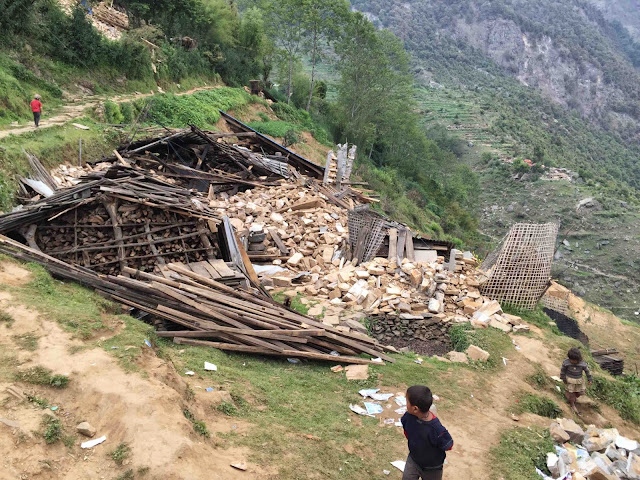[We then moved our focus on the hundreds of patients that had already lined up. As we setup our registration area, we saw that the locals were engaged in an animated discussion. I inquired what was going on and what I heard humbled me as a “relief worker” and made me proud of being a Nepali.]
By Bijay
Acharya, MD
Massachusetts General Hospital
Massachusetts General Hospital
 |
| Singla, Gorkha |
We landed
on a small piece of rock formation that had visible cracks from the quake. Our
extremely skilled pilot placed the bird on the stable part of the rock and we
quickly unloaded our materials and medications. As we hiked some 500 ft uphill
to set up our camp in the school area, we saw the destruction that the quake
had caused. There were cracks all over the grounds of the village. We used the
remaining undamaged classrooms of the local primary school as our clinic site.
Locals pointed out that they had recently covered cracks on the school ground
using dirt and stones.
The
Earthquake
 |
| Aftermath |
The first quake wiped out nearly all the
houses in the villages and the aftershocks crushed every old structures that
remained standing. Before starting medical services, we took a quick tour of
the village. All we saw was rubble: what remained of the houses was piled over
one another. What used to the streets was now filled with debris and what
filled people’s homes: torn clothes, shoes and books. . Granaries lost,
utensils crushed, latrines destroyed. A stench of decaying animals and human
waste hung in the air. A couple was trying to get into their house from a
destroyed roof. The wife got into the attic by moving the tin sheets and
retrieved a blanket. It was covered with dust and a part of it looked burnt.
She cut the burnt part with a sickle and saved the blanket. It is cold in the
mountains.
By the time
we returned from our quick tour, the school grounds had turned into a makeshift
medical camp, filled with patients waiting to seen. A young boy with a deep
wound in his foot from falling rocks was brought forward. His wound was
infected, requiring surgical debridement and intravenous antibiotics. An
elderly woman had a fractured ankle and had received no treatment. Both of them
needed to be evacuated immediately, and they were taken away in our chopper to
Gorkha Hospital, a 10 min flight that they had to wait more than 10 days for.
We then
moved our focus on the hundreds of patients that had already lined up. As we
setup our registration area, we saw that the locals were engaged in an animated
discussion. I inquired what was going on and what I heard humbled me as a
“relief worker” and made me proud of being a Nepali.
Atithi-devo
bhava (“Your guest is equivalent to God”)
Nepal is known for its respect and love
for the hundreds of thousands of guests that come to visit the country. I saw
this tradition alive in Singla. They were having discussions about who was
going to hand over the rice and food materials they had saved to feed our
15-person medical team. Singla hadn’t had a single food drop since the
earthquake and people were skipping meals every other day to ration their own
food. Despite this, they were offering us meals. We vehemently disagreed and
informed them that we had brought our own food. They then insisted that they
would do the cooking. No one seemed to mind that we still hadn’t started the
clinic because despite losing virtually all of their possessions, they were
busy making generous offers that we simply could not accept. The final
compromise was that our team would cook but we would use their pots, pans and
utensils. Everyone was happy and we started seeing patients.
The
destruction faced by people in Singla from the disaster was overwhelming but
that was well-matched by their generosity.
@ Medium

